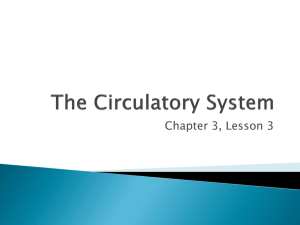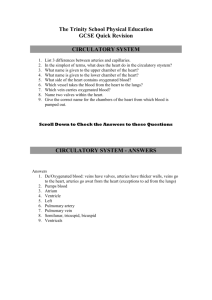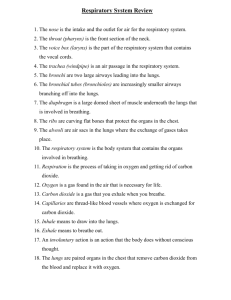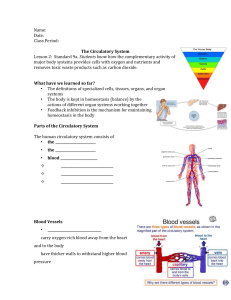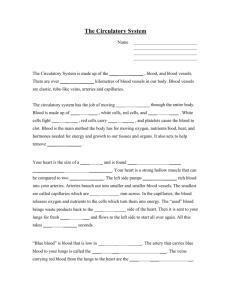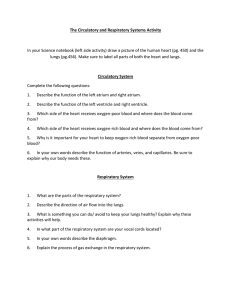The Circulatory and Respiratory Systems
advertisement
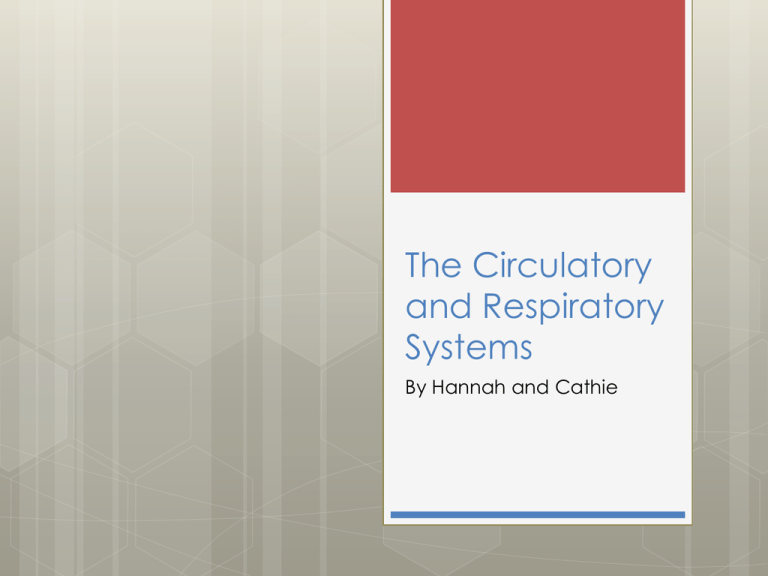
The Circulatory and Respiratory Systems By Hannah and Cathie The Circulatory System Overview body has about 5 liters of blood continually traveling through it three distinct parts: pulmonary circulation (lungs), coronary circulation (heart), and systemic circulation (rest of system). Blood Main Components 55 percent of blood is plasma, a strawcolored clear liquid which carries the solid cells and the platelets Red blood cells White blood cells Blood Functions delivers essential elements and removes harmful wastes transports oxygen from the lungs to body tissue and carbon dioxide from body tissue to the lungs transports nourishment from digestion and hormones from glands throughout the body transports disease fighting substances to the tissue and waste to the kidneys Red blood cells and white blood cells are responsible for nourishing and cleansing the body. Blood: Red Blood Cells contain a protein chemical called hemoglobin which is bright red in color and contains the element Iron (attracts oxygen and carbon dioxide) As blood passes through lungs, oxygen molecules attach to the hemoglobin As blood passes through the body's tissue, the hemoglobin releases the oxygen to the cells Empty hemoglobin molecules then bond with the tissue's carbon dioxide or other waste gases, transporting it away Get worn out and eventually die, average life cycle is 120 days Blood: White Blood Cells either produce protective antibodies that will overpower germs or surround and devour the bacteria Short life cycle, living from a few days to a few weeks. A drop of blood can contain anywhere from 7,000 to 25,000 white blood cells at a time, number will increase during infection Structure of Veins and Arteries: The Heart four cavities, or open spaces, inside the heart that fill with blood. Two atria on top, two ventricles on the bottom The septum separates the right and left sides of the heart. A valve connects each atrium to the ventricle below it. The top of the heart connects to a few large blood vessels. Aorta- or main artery, largest, carries nutrient-rich blood away from the heart Pulmonary artery- connects the heart with the lungs as part of the pulmonary circulation system Structure of Veins and Arteries: The Heart Structure of Veins and Arteries: The Heart Cardiac muscle contracts and relaxes, pushing blood through the chambers and into the vessels, without you ever having to think about it. Nerves connected to the heart regulate the speed with which the muscle contracts. Structure of Veins and Arteries: Blood Vessels Blood vessels are hollow tubes that circulate your blood 3 types: arteries, capillaries, veins Structure of Veins and Arteries: Blood Vessels Arteries carry blood away from the heart main artery then branches into many smaller arteries so that each region of your body has its own system of arteries supplying it with fresh, oxygen-rich blood. Arteries are tough on the outside and smooth on the inside. 3 layers: an outer layer of tissue, a muscular middle, and an inner layer of epithelial cells. Structure of Veins and Arteries: Blood Vessels Veins- veins carry the blood back to the heart receive blood from the capillaries after the exchange of oxygen and carbon dioxide has taken place transport waste-rich blood back to the lungs and heart allow blood to flow against the force of gravity Structure of Veins and Arteries: Blood Vessels Capillaries- capillaries connect the arteries to veins Capillaries are very thin and fragile The exchange of oxygen and carbon dioxide takes place through the thin capillary wall The red blood cells inside the capillary release their oxygen which passes through the wall and into the surrounding tissue- waste projects leave the tissue the same way Arteries and veins run parallel throughout the body with a web-like network of capillaries connecting them Open and Closed Systems Closed circulatory systems- (vertebrates) In this type of system, blood is pumped by a heart through vessels, and does not normally fill body cavities; blood remains within blood vessels, pressure is high, and blood is therefore pumped faster Open circulatory system- (evolved in crustaceans, insects, mollusks, arthropods and other invertebrates) pump blood into a hemocoel with the blood diffusing back to the circulatory system between cells; blood is pumped by a heart into the body cavities, where tissues are surrounded by the blood; blood flows slowly in an open circulatory system because there is no blood pressure after the blood leaves the blood vessels; the animal must move its muscles to move the blood within the spaces. Mammalian Double Circulation Refers to the separate systems of pulmonary circulation and the systemic circulation in amphibians, birds and mammals (including humans) All animals with lungs have a double circulatory system Double circulation has two routes or circuits: Heart—lung—heart(pulmonary circulation) Heart—body—heart(systemic circulation) Mammalian Double Circulation The right ventricle pumps blood through pulmonary artery to lungs for purification Blood returns to left auricle through the pulmonary vein Blood then comes to the left ventricle from here is pumped to the arteries to the rest of the body The impure blood returns to the right auricle and then goes to the right ventricle Advantage of a double circulatory system The heart can increase the pressure of the blood after the blood has picked up oxygen from the lungs which means it can transport it to the body tissues much quicker. Evolution Chambers of the Heart Contraction of the atria and ventricles forces blood out Blood flows in one direction due to valves that prevent backflow. Small animals may not need a circulatory system because the interior cells are close to the surface (they have a high surface-to-volume ratio)and can obtain sufficient oxygen absorption directly through their skin while wastes move a short distance to the surface and diffuse into the environment. Most invertebrates and all vertebrates have interior cells that are too far from the body surface to exchange substances efficiently. They require a circulatory system. Interaction with other Systems Transport of materials: Gasses transported: Oxygen is transported from the lungs to the cells. CO2 (a waste) is transported from the cells to the lungs. Transport other nutrients to cells: Glucose transported throughout the body; the liver maintains a constant level of glucose in the blood. Transport other wastes from cells: Ammonia produced and transported to the liver where it is converted to less toxic urea; Urea then transported to kidneys for excretion in the urine Transport hormones Contains cells that fight infection Helps stabilize the pH and ionic concentration of the body fluids Helps maintain body temperature by transporting heat The Respiratory System Overview Combined system of heart and lungs is called cardiopulmonary system Three distinct stages: the process of breathing, which involves the movement of air into and out of the lungs (pulmonary system); the exchange of gases between the internal surface of the lungs and the blood; the exchange of gases between the blood and the cells of the body Gas Exchange Surfaces The steps of respiration: 1. Ventilation- Air enters lungs (inspiration), air leaves lungs (expiration) 2. External respiration- Gas exchange between air and the blood in lungs. When the blood then has oxygen, it transports it to the tissues 3. Internal respiration- Gas exchange between blood and tissue fluid. The tissue fluid gives the blood carbon dioxide in exchange for oxygen, which the blood then transports back to the lungs to be expired out Gas Exchange Surfaces Surface must be moist, thin, and large in relation to size of body Examples of Gas Exchange Surfaces: Lungs (in terrestrial animals) Gills (aquatic animals) Body surface (Annelids/segmented worms) Tracheae (insects) Structures and Functions of the Respiratory System in Humans http://www.virtualmedicalcentre.com/vide os/how-lungs-function/836 Structures and Functions of the Respiratory System in Humans Structures and Functions of the Respiratory System in Humans Lungs Main organs of the respiratory system Responsible for breathing, and are where the main activities occur Oxygen is breathed into the lungs and taken to the rest of the body by red blood cells, while carbon dioxide is breathed out Structures and Functions of the Respiratory System in Humans Trachea (windpipe) Filters the air we breathe Divides into two bronchi, which enter the right and left lung Bronchi Extensions of the trachea, and there is one in each of the lungs 2 primary tubes in the lung that brings the lungs air Structures and Functions of the Respiratory System in Humans Diaphragm Dome shaped muscle located at the bottom of your lungs Breathing in causes the diaphragm to contract, and it flattens out again when you breathe out Larynx (voice box) Helps food not go down the trachea, helps you breathe, and contains vocal cords Located at the top of the throat. Structures and Functions of the Respiratory System in Humans Alveoli Primary gas exchange surfaces of the lungs Thin little sacs Located on the end of the bronchioles Inflate when you breathe in, and deflate when you breathe out Inspiration and Expiration Inspiration: The external intercostals muscles contract and the inner ones relax The rib cage moves upwards and outwards. The muscles of the diaphragm contract and it flattens/loses its dome shape These movements increases the volume of the thoracic cavity ; and that of the lungs. Pressure in the lungs is then decreased; lower than the atmospheric pressure. This forces the air to rush into the lungs (through the trachea). Inspiration and Expiration Expiration: The internal intercostals muscles contract while the external intercostals muscles relax. The rib cage moves downwards and inwards. The muscles of the diaphragm relaxes; causing it to assume its dome shape. The volume of the thoracic cavity decreases; resulting into decrease in the volume of the lungs. The pressure in the lungs increases higher than that of the atmospheric pressure; air (carbon dioxide) is then forced out of the lungs. Functions of hemoglobin in the transport of O2 to Co2 http://www.youtube.com/watch?v=PdGD AvpcM6Q Regulation of Blood ph Controls the acidity of blood by regulating the elimination of CO2 and H2O A significant increase in CO2 or decrease below pH 7.38 of arterial blood - causes breathing to increase (in rate and depth) - results in hyperventilation - more CO2 is exhaled - eliminates CO2 - reduces H2CO3 and H+ concentrations - increases pH back to normal A significant decrease in CO2 or increase in pH - causes breathing to decrease - results in hypoventilation - less CO2 is exhaled - increases CO2 - increases H2CO3 and H+ concentrations - decreases pH back to normal Diseases and Disorders of the Respiratory System Asthma One of the most common respiratory disorders About 34 million people in the United States suffer from asthma Disease of the bronchi that causes the effected to cough, wheeze, produce mucus, and often become breathless. Occurs because of irritants, which can be different for certain people Asthma can’t be cured, but there are treatments. Diseases and Disorders of the Respiratory System Emphysema Chronic lung disorder that results from damage to the alveoli in the lungs Most common cause of emphysema is smoking Walls in the alveoli are so damaged that the surface area for gas exchange is significantly reduced, therefore making it hard for your body to get the oxygen it needs Alveoli also burst and fuse into enlarged air spaces Emphysema is not curable. Diseases and Disorders of the Respiratory System Laryngitis Swelling and inflammation of the voice box (larynx). Caused most frequently by upper respiratory infections (usually viral) Larynx (located at the top of the trachea), contains the vocal cords, so when the larynx becomes infected it swells, cutting off the ability to speak altogether, or just making your speech hoarse. Other symptoms besides loss of voice are fever, swollen lymph nodes. Works Cited http://www.webmd.com/asthma/default.htm http://www.nlm.nih.gov/medlineplus/emphysema.html http://hes.ucfsd.org/gclaypo/repiratorysys.html http://gskool.com/biology/inspiration_expiration.htm http://www.hartnell.edu/faculty/shovde/chem23/Body %20Fluids/Respiratory%20control%20pH.htm http://www.fi.edu/learn/heart/systems/circulation.html http://faculty.clintoncc.suny.edu/faculty/michael.grego ry/files/bio%20102/bio%20102%20lectures/circulatory%20 system/circulat.htm http://www.circulatory-system.com/double-circulatorysystem/ http://www2.gsu.edu/~bioasx/closeopen.html

